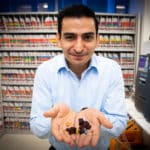UPDATE 22 February 2018:
A vaccine has been developed against rotavirus, which is the common cause of severe diarrhoea and a killer of approximately 215,000 children under five globally each year.
The oral vaccine was given in three single doses, the first within five days of birth. After three doses of RV3-BB administered from birth:
- 94 per cent of infants were protected in their first year of life against severe rotavirus gastroenteritis
- 75 per cent of infants were protected to 18 months of age.
The success of the RV3-BB vaccine is the culmination of more than four decades of work, which started with the Murdoch Children’s Research Institute’s Professor Ruth Bishop and the discovery of rotavirus in 1973.
The trial was funded by the National Health and Medical Research Council (NHMRC), Bill & Melinda Gates Foundation and PT BioFarma.
Read the full media release on the MCRI website.
——
A new rotavirus vaccine should soon be available thanks to a collaboration between PT Bio Farma and researchers in Melbourne and Yogyakarta. The new ‘RV3’ vaccine is aimed at protecting babies from birth, improving protection and simplifying delivery.
The current vaccine, available in Australia and only on the private market in Indonesia, can only be administered from six weeks of age.
Continue reading Keeping ahead of a child killer: stopping gastro from birth →












